The humor … the humor …
—
Comics and the Bible have always made for one heckuva combo. I remember as a kid getting an awesome paperback collection of Bible comics at my local synagogue. If memory and modern research serve me right, it reprinted the Golden Age DC and EC Bible comics edited by the legendary M.C. Gaines. And of course, Joe Kubert’s treasury collection from DC is a Bronze Age classic.

Writer Mark Russell (recently of DC’s Prez revival) and New Yorker cartoonist Shannon Wheeler have taken that idea one step further, first with 2013’s God is Disappointed in You and its new follow up, Apocrypha Now. Both books feature humorous, irreverent, yet also insightful analyses — in prose and cartoon form — of the best- and not-so-best-known stories from the Bible and related literature.
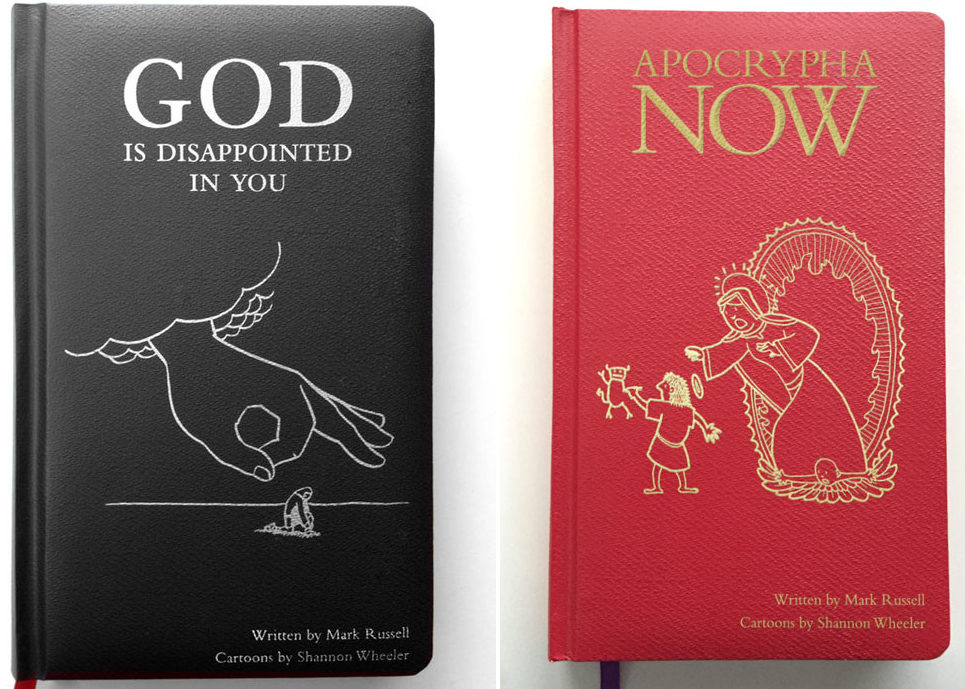
Apocrypha Now has just hit comics shops and lands in book retailers 5/31. Both volumes are designed like hotel-room Bibles and you can pick them up separately or in a new slipcase 2-pack from Top Shelf/IDW.
Now, if you want a real taste of what these books are like, here’s Russell himself, with 13 Bible Stories that Would Make Great Comic Books. (Oh, and I’ve added some of those original Gaines comics covers — and some other surprises — because they’re pretty dang awesome. — Dan
—

By MARK RUSSELL
Ultimately, we read to learn about ourselves. Some of us paid attention to the Bible stories in Sunday School, others secretly read comic books at the back of the church. Whichever one you were, you received an education in the nature and application of power.
I think superheroes have retained the fascination of people for the last 80 years or so for much the same reason that the Bible has for the last 2,000 — because we feel small and powerless in a terrifying world that is beyond our control and we need stories to help us cope. To act as a thought experiment in how the world should be, if only we could make it so. In that sense, comic books and religious texts serve much the same purpose, so crossovers seem perfectly natural.
Here are 13 stories pulled from the Holy Bible or other Biblically-related literature that I think would make particularly good comic books:
—
Cain vs. Abel. A classic supervillain origins story. God continually refuses Cain’s sacrifices of grains and cereals, while lapping up his brother Abel’s sacrifices of succulent sheep and goats. God is apparently on the Atkins Diet. Cain starts out good, but he can’t handle being jilted by God and becomes consumed with sibling rivalry. Pushed over the edge, Cain kills his brother in a jealous rage, and then God tramp-stamps him, disfiguring Cain with a mark on his forehead that tells the entire world he is a murderer. Like the Joker, Cain is forever defined by One Bad Day. Bonus points: In the Jewish Midrash, there’s a hilarious but completely logical scene where, because this is the first murder EVER, Cain smashes Abel in random places all over his body trying to figure out how to kill a person.
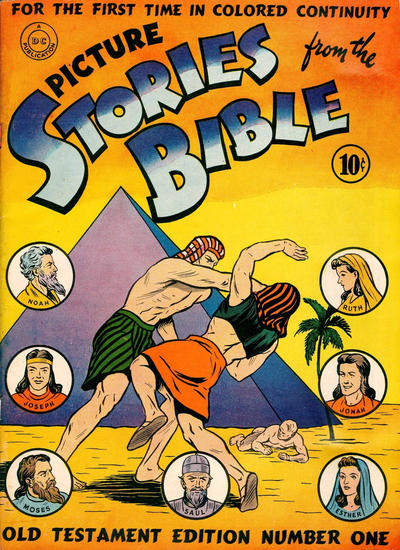
—
Abraham vs. the Elamites. From the fantastical version of the story told in the Jewish Midrash, not the drier version in the Bible. In one of the all-time great team-ups, Abraham sets out to rescue his nephew Lot, who has been captured by a tribe of douchey Elamites. He is joined by his manservant Eliezer as well as the Angel of Death and (digging deep into the Super Friends’ bullpen) the planet Jupiter. God makes Abraham as tall as a six-story building and gives Eliezer the strength of 300 men. What ensues are guys in bronze armor getting thrown across the battlefield, gruesome stompings, and the Angel of Death collecting the souls of the dead. Jupiter acquits itself nicely as well. Lot is rescued only to land back in hot soup later when he settles in a party town called Sodom.
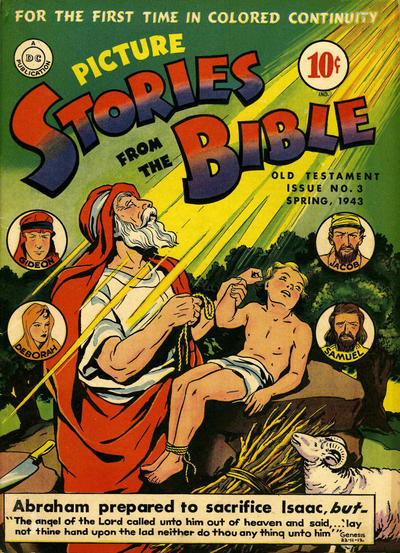
—
Deborah, the Hazorite Slayer. The original “strong female protagonist,” Deborah ruled Israel as judge at a time when they were being picked on by larger, more sophisticated tribes. The Hazorites were one such people. At one point, they had Deborah trapped atop Mount Tabor. The Hazorites didn’t take the Israelites very seriously. Deborah’s army was apparently armored in wicker and bed pillows. Their weapons were mostly stupid-looking Bronze Age sickle-swords. The Hazorites, clad in state-of-the-art body armor, rolling around with chariots and heavy spears, simply camped out at the bottom of the mountain, waiting for their outclassed enemies to come down to the slaughter.
The odds stacked against her, Deborah nonetheless had a card up her sleeve. She waited for rainfall and then launched an attack down the west side of the mountain at sunrise. Because they were forced to look up into the east, the Hazorites couldn’t see their attackers without being blinded by the rising sun. In addition, the mud created by the rain from the night before bogged down their chariots and made it so they couldn’t move around in their body armor. They were sitting ducks for Deborah’s troops who were as light on their feet as a lacrosse team. The Hazorites were routed and forced to indefinitely postpone their trophy party.
Extra Girl Power points: Sisera, the general of the Hazorite army, fled to the tent of a nearby farmer. The tent belonged to a woman named Jael, who served Sisera some warm milk, and then when he fell asleep, drove a tent peg into his skull. Be careful who you camp with.
—
The Death Box. The atom bomb of the ancient world, the Ark of the Covenant was a magical box the Israelites carried into battle. The Ark of the Covenant was proof that they were God’s favorite people. It even had a little seat on top for God to ride around in. When they took the Ark into battle, they could rest easy. The death box would take care of everything—setting enemies on fire, bursting their organs, etc. Even when the Philistines managed to capture the Ark, it just afflicted them with butt cancer and rats. When not used in battle, though, the Ark could be something of a pill. One time a priest reached up to keep it from slipping off its ox cart and it killed him. This freaked King David out a little, so he decided having the Ark in the royal palace wasn’t such a hot idea. Eventually, they built the Death Box a house of its own and called it the Temple of Solomon.
—
Hosea: A Minor Prophet with Major Problems. I see this one being more like a Chris Ware or Robert Crumb indie comic. Hosea is a minor prophet. And not very good at his job. God mysteriously orders Hosea to marry a loose woman. Every day he’s out in the town square, imploring the people of Israel to give up idolatry and return to worshiping God, but it’s hard for anyone to take him seriously because they all know that while he’s preaching to them, his wife is out there banging every shepherd in town. Hosea repeatedly catches her cheating and throws her out of the house, but she keeps crawling back to him, and of course, being a loser, he always takes her back.
Hosea goes back out to preach, but everyone just snickers at him. Finally, someone works up the nerve to ask him how he can possibly take his wife back after she’s cheated on him so many times.
“Because,” he replies, “it is no different than how we cheat on God, and yet, he is always willing to take us back.” And people finally got it. Hosea had gotten through to them. Best drawn with lots of moody cross-hatching and wavy anxiety lines.
—
The Acts of Peter. Two words: magic battle. Peter is traveling the world telling people about Jesus, as one does, when he awkwardly runs into someone else, a guy named Simon Magus, doing the same thing. They both claim to be the sole legitimate authority on Christ, and unable to tell which one was the false prophet, the people decide to settle the matter with a magic battle. After a few warm-up tricks doing things like bringing fish back from the dead and making dogs talk, Peter and Simon get down to some serious magic. Peter thinks it’s going OK, but then Simon plays his Power Nine card. The crowd gasps in awe as Simon’s feet leave the ground. Soon, he is levitating over their heads. Then the crowd breaks into a cheer as he is zipping around in the sky like Ultraman. Peter has no answer to Simon’s magic and things are looking grim. But then Peter remembers that he actually is the true representative of Christ so instead of trying to match Simon’s magic, Peter simply prays for Jesus to take away the imposter’s magic powers. Jesus complies and Simon Magus sputters mid-flight and falls from the sky, crashing head-first into the dirt and breaking his neck. The crowd erupts into laughter, declares Peter the winner, and stones Simon Magus to death.

—
The Maccabees. From the Apocrypha, the Maccabees recounts the story of the Jewish revolt against the Greeks. Mel Gibson was going to turn it into a movie until he suffered his 19th nervous breakdown. But that’s OK, I think it would work better as a Frank Miller comic, anyway. The Maccabees’ uprising is a gruesome and violent tale that includes, among other things: boys jumping to their deaths into a giant frying pan to avoid eating pork, battle elephants hopped up on energy drinks, and a guy throwing his own guts and entrails at enemy soldiers. So yeah, it pretty much has it all. And given that it ends with the Jews victoriously kicking the Greeks out of Israel but then ominously sealing an alliance with the Romans, things are totally left open for a sequel.
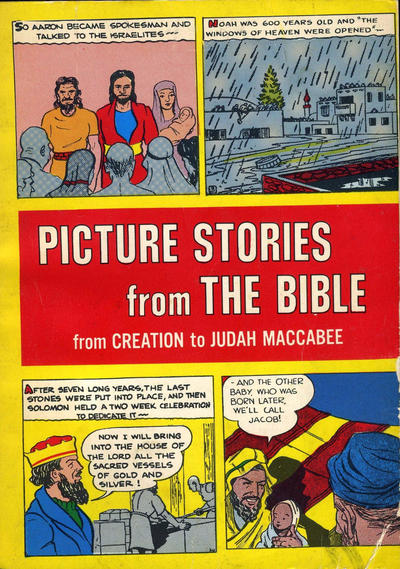
—
The Story of Susanna. Also from the Apocrypha, the Story of Susanna would have worked really well as a true-crime noir comic before the Comics Code Authority came in and ruined everything.
Susanna was a Jewish woman, the trophy wife of a rich Babylonian man named Joaquim. Joaquim was always away on business, leaving Susanna to spend her days luxuriating by the pool and strolling through the majestic gardens of their estate. Good work if you can get it, but life is never quite so simple. A couple of Joaquim’s advisers get an eyeful of Susanna and become so infatuated with her that they try to blackmail her into having sex with them. When Susanna refuses, they run through the streets, accusing Susanna of having an affair with the pool boy, right there in her husband’s prize garden.
Already sketchy on foreigners, women and mixed marriages, the people take these two respected men’s word at face value and an angry mob forms. (One great storytelling device of the Bible is that it usually takes about two seconds to get an angry mob going.) They carry Susanna into the public square and are getting ready to execute her for adultery when the Prophet Daniel stops by.
Daniel immediately stops the angry mob and drops a little Police Work 101 on their ass. He separates the two advisers and then one by one, asks them where in the garden they caught her having sex. When they don’t come back with the same answer, the crowd realizes the two men made the whole thing up and, not letting an angry mob go to waste, they stone the two liars to death.
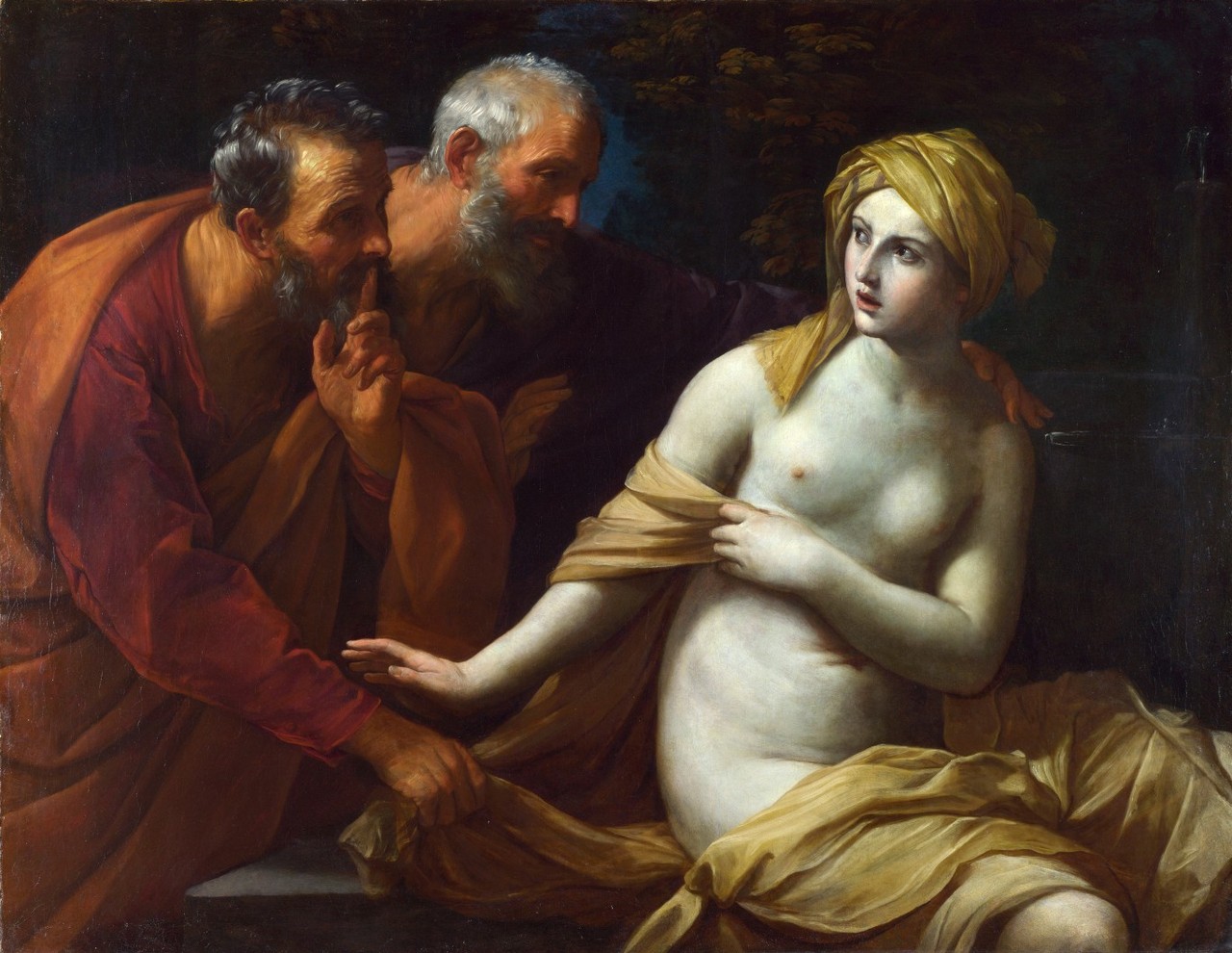
Guido Reni
—
Tobit. One of the craziest stories in Biblical literature. Tobit is a merchant, a silver and camel man, who goes blind when a bird shits in his eyes. Both of them, apparently. Now unable to support his family, he sends his son on a business trip to collect some silver he is owed. He hires a mysterious guide for the young man, and the pair have a series of adventures that include being attacked by a fish, having to thwart a demon with a stink bomb, and bravely marrying a virgin who had been married seven times, with all seven men dying on their wedding night.
Upon returning his son home to Tobit, the guide reveals that he is, in fact, the Angel Raphael and squeezes the guts of the fish that attacked them into Tobit’s eyes, which cures him of blindness. Homeopathic medicine saves the day and everyone is happy.
—
Ahab and Jezebel. The story of Ahab and Jezebel is sort of like Married … with Children, but with more people getting eaten by dogs.
Ahab was a bumbler and Jezebel was always making him feel small with her cutting remarks, but somehow they made it work and ruled Israel together as king and queen. But Ahab and Jezebel worshiped a local rain god named Baal, which really rankled God. So God challenged Baal to a cook-off. God’s prophet Elijah challenged Baal’s priests to set up two altars. Whichever one sent fire down from Heaven to consume the meat would be declared the one true God. These sort of contests were popular in the ancient world.
Baal’s priests couldn’t summon so much as a hot day from Baal. But when Elijah prayed to God, a jet of flame shot down to Earth, consuming his sacrificial meat. Then, as a prank, the flames also consumed Baal’s priests.
Elijah warned Ahab and Jezebel that because of their idolatry, they and their family would not only be killed, but be devoured by birds and dogs. Soon after, Ahab was mortally wounded in battle. His men carried him off to die, but not before hungry dogs lapped up his blood. Ahab’s heir Joram was killed by a usurper, his body dumped in a field where it was picked clean by birds. Then the usurper showed up at the royal palace where Jezebel appeared on the balcony with her eunuchs and acidly asked if it was not enough that the upstart had killed her son, but needed to destroy the breasts that suckled him as well? Jezebel’s eunuchs, realizing the jig was up and wanting jobs in the new administration, pushed her from the balcony to her death, whereupon she was gobbled by several starving dogs, which apparently were everywhere in those days.
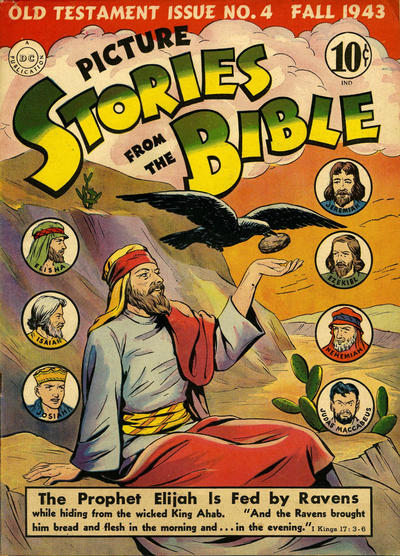
—
Ruth. I think this could work as sort of an Archie comic about a homeless lady. Ruth works as a gleamer, picking through the crops left over after the harvest, in order to support herself and her mother-in-law, both of whom are widows without a pot to piss in. This wasn’t a good life. They never had any money and all they had to eat were trampled turnips and broken onions. Basically, they lived off garbage salad. One day, she was working the fields of a man named Boaz. But when Boaz saw Ruth’s devotion to her mother in-law, he instantly fell in love with her.
Boaz wanted to marry her, but according to Jewish law, her dead husband’s closest male relative had the sacred right of “dibs.” Though the offer was a formality, Boaz was worried that when this guy saw how beautiful Ruth was, he would take him up on it and marry Ruth himself. So Boaz hatched a ruse whereby he offered the man a sweet piece of land at rock-bottom prices, adding only in the fine print that the buyer also had to marry a widow, sight unseen. This was not the relative’s first chariot race. He knew to read the fine print, and when he discovered that the clause about marrying some widow had been cleverly snuck in, he immediately smelled a rat.
The man refused the land deal, and consequently, the offer to marry Ruth. Boaz and were now free to marry, which they did. And they lived happily ever after, despite the fact that their relationship was built upon a real estate scam.
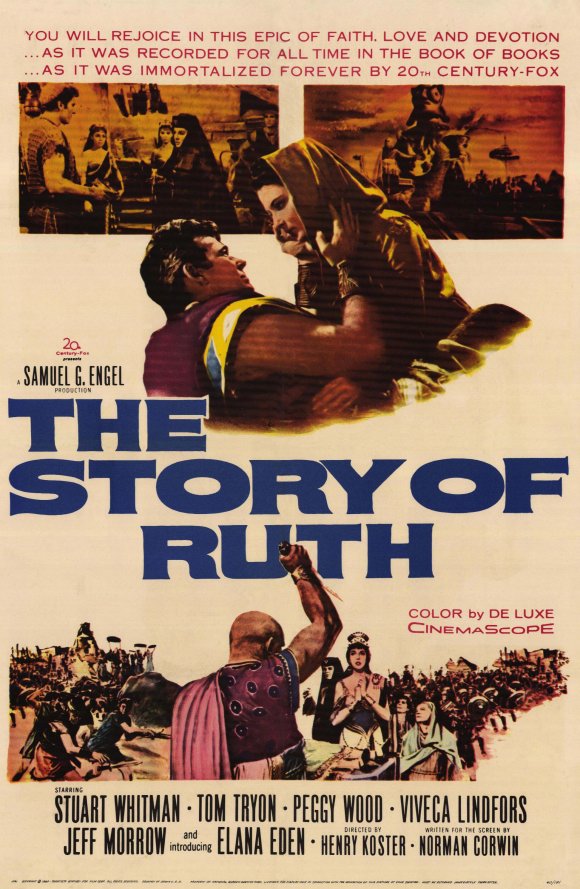
—
The Gospel of Judas. From the non-canonical Gnostic Gospels, The Gospel of Judas would be best as a gritty one-off, telling the story of Christ’s betrayal from the perspective of the “villain.” The Gospel of Judas begins with the disciples waking from the same unsettling dream. In their dream, there were 12 priests, sacrificing babies upon an altar. Out of babies, the priests began cutting their own families to pieces and feasting on their flesh, blood and gore dripping down their robes. When the disciples asked Christ what such a hideous vision could mean, he replied that they were the 12 priests from the dream. That when he was gone, they would abandon his teachings and butcher his followers upon the altar of their own ambitions. This wasn’t a very pleasant thing to hear, so it caused a bit of a ruckus, with the disciples deflecting the accusation and squabbling amongst themselves.
Christ retreated from the fracas, taking Judas with him. It was then that Jesus revealed to Judas that it was his destiny to be crucified. Christ then asked Judas to help fulfill his mission on Earth by betraying him to the police. Christ reasoned that Judas was the only one he could trust with such an awful assignment because he was the only disciple not obsessed with taking over once he was gone. Judas tearfully agreed, proving himself Christ’s one true disciple by selling out his beloved teacher, even though it meant both Christ’s destruction and his own.
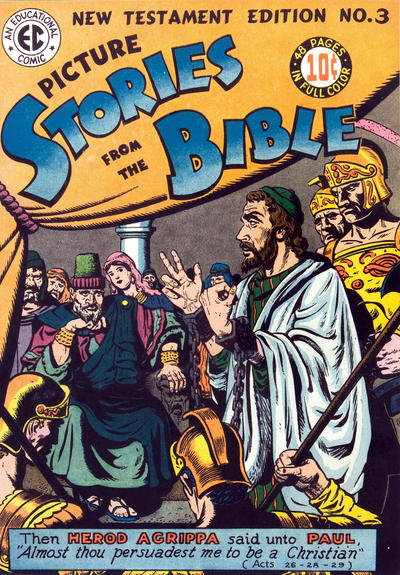
—
The Book of Revelation. As perhaps the most horrifying entry in the annals of religious literature, this one goes without saying.
Sick of being pushed around, Christ cracks open the Seven Seals, none of which are very nice. It starts with the release of the Four Horsemen, the death of a quarter of the world’s population and just goes downhill from there. There’s earthquakes, famines, falling stars. Things get so bad that people will just walk into a cave in hopes it will collapse on them.
Finally, when the Seventh Seal is opened, the world gets a break from all the destruction. This break lasts for all of half-a-freaking-hour, and then it’s right back to hailstones made of blood and monsters ripping the heads off babies. Did I mention that now the world is ruled by a beast with obscenities scrawled on his heads? To make matters worse, the beast is not a very effective head of state. On his watch, the seas turn to poison, all the fish die, the sun goes dark, people are flopping over dead by the million. A re-election bid does not look likely.
Then, when it looks like the Earth is finally past the point of no return, Christ suddenly returns with an army and destroys the Beast. In an act of divine regime change, God takes over and rules the Earth himself. The Kingdom of God now in full effect, the world recovers, becomes a paradise, and everyone lives happily ever after.
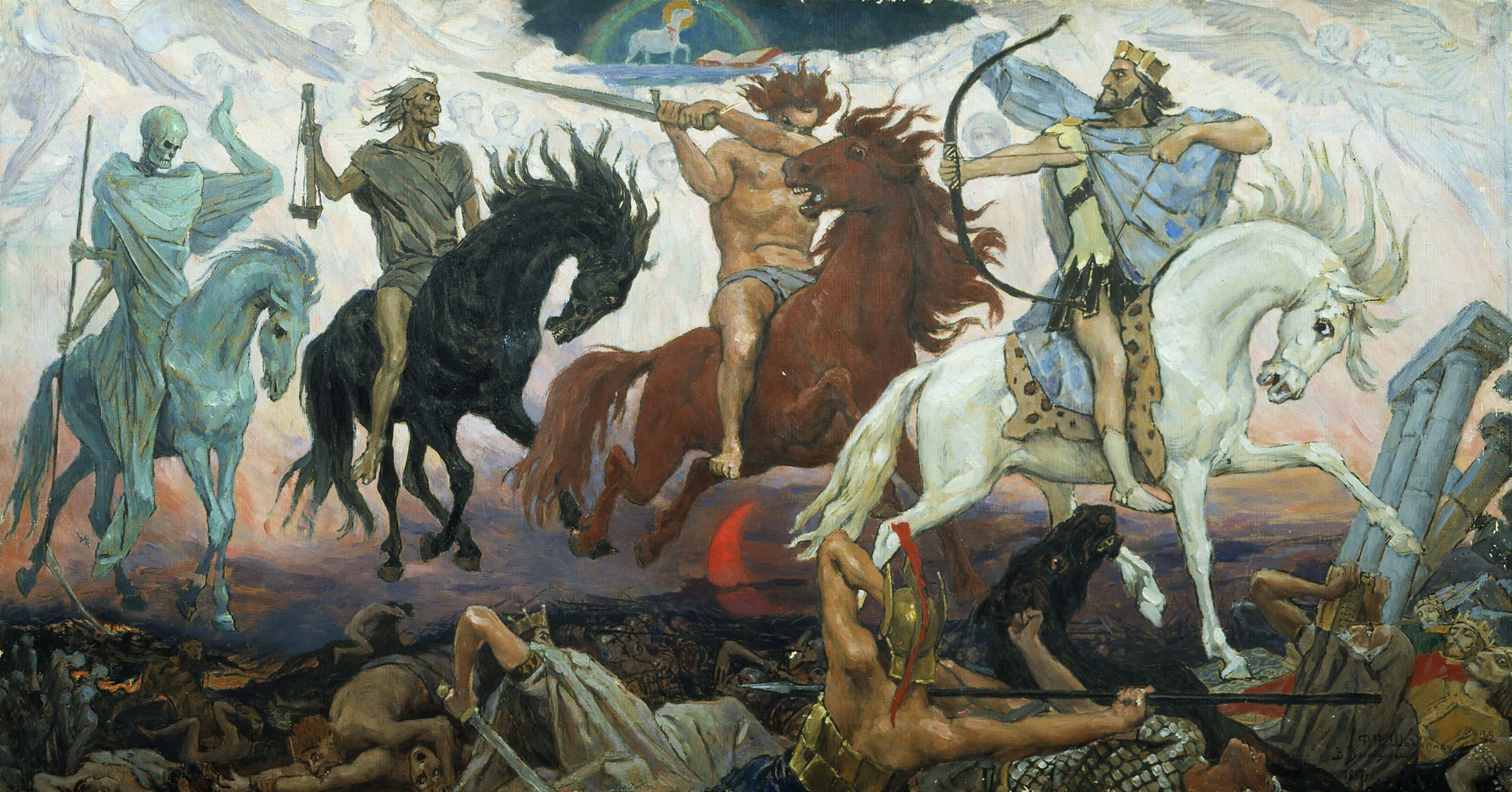
Viktor Vasnetsov, 1887
